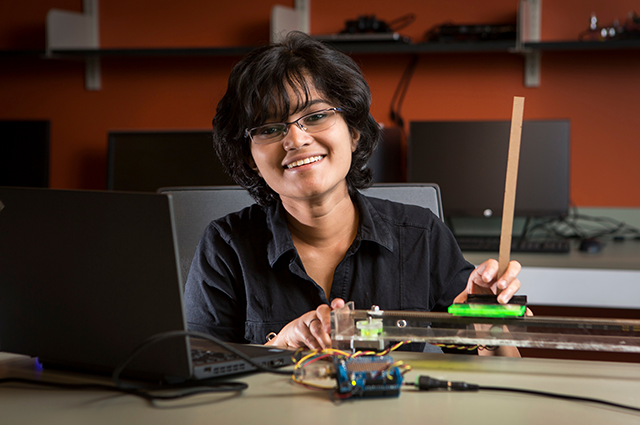Defying gravity with an inverted pendulum

By Lynne Powers
The Summer Scholars program provides rising juniors and seniors with the opportunity to conduct funded independent research projects as undergraduates. The 2016 summer scholars came from across Tufts schools, departments, and disciplines. The nine engineering majors who received funding spent the summer working with their faculty advisors and, during program support events organized by the Office of Undergraduate Education, rubbing shoulders with their peers from the School of Arts and Sciences. From automobile emissions to zwitterions, their summer research projects sought solutions to many of the biggest problems we face today.
Simply put, a pendulum is a weight suspended from a frictionless pivot. The common example is the swinging weight of a grandfather clock. When the clock's pendulum is lifted to the side and dropped, a restoring force — due to gravity — accelerates it back toward its equilibrium position. An inverted pendulum, meanwhile, is precisely what it sounds like: a pendulum turned on its head. With its center of mass lying above its pivot point, an inverted pendulum cannot rely upon gravity to return it to its equilibrium position. In fact, gravity works against it.
Anu Gamage, E18, gives the example of a childhood game with a pencil. “If you're trying to balance a pencil on your hand, you have to constantly move your hand to apply force to balance it,” she says. The more complex inverted pendulums found in robotics systems typically have in-built sensors that allow the pendulum system to provide the appropriate amount of force to balance itself. What happens, though, when there's a bug in the software?
Gamage's plan is to separate the pendulum system from its sensor. A backup external sensor would allow the pendulum system to continue collecting accurate measurements and balancing itself in the case of a cyberattack or a bug that took down its internal sensor. Her project for the summer had three main stages. Step one was to build an actual inverted pendulum, collaborating with mechanical engineering major Chandler Coble to design and assemble the pendulum in Bray Laboratory. Gamage, meanwhile, also set up the sensors, microcontrollers, and motors necessary to control the system.
The inverted pendulum and some of the motors and sensors that control it. The second stage of the project was working with faculty advisor Assistant Professor Usman Khan to develop mathematical models that could describe and predict the system's behavior. For that stage, Gamage used the traditional method of an internal sensor as she figured out algorithms to control the pendulum. Her final step would be to build an external sensor – which was a camera system – to capture a running visual feed of the pendulum's motion and process those images to get the data needed to control it.
Gamage will continue her project through at least the fall semester. She is currently finishing the second stage — working out the algorithms to control her inverted pendulum using an internal sensor — before moving on to using an external camera to control it. The pendulum currently can balance for small deviations, like if the pendulum is a few degrees off from a vertical line. Ideally, Gamage says, the pendulum will be robust for larger disturbances of tens of degrees.
It's no small task, but Gamage — the incoming president of the Tufts IEEE student chapter as well as the newly elected treasurer for the Tufts Robotics Club — is up to the challenge.
Related Links
Filtering clean drinking water
Modeling air pollution in Boston
Department:
Electrical and Computer Engineering